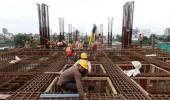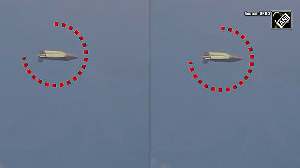Given the developments, analysts expect fiscal and monetary support from the government and RBI to revive sentiment.
However, recovery, they say, from these levels will be slow and painful.

The sharp fall in the markets from their recent peaks, triggered by the pandemic, is factoring in the 21-day lockdown to an extent.
However, recovery from these levels will be slow and painful, say analysts.
Given the developments, they expect fiscal and monetary support from the government and the Reserve Bank of India (RBI) to revive sentiment.
At the same time, they expect the markets to remain choppy as they track the pandemic-related developments.
“Ever since the announcement of the ‘Janta Curfew’, the market was anticipating a longer lockdown.
"The fall in the Nifty has more than adequately factored in the three weeks of earnings that most firms will have to forego.
"A big rate cut by the RBI, alongside waiver of non-performing asset (NPA) norms for a period of time, is all but inevitable.
"The government is taking the fight against COVID-19 deep into the summer with hope that the heat will ultimately eviscerate the virus.
"The fight has to be won before the monsoon arrives. Else, all hell could break loose,” said Saurabh Mukherjea, founder and chief investment officer (CIO) of Marcellus Investment Managers.
From their peaks in January 2020, the Sensex and Nifty have slumped close to 37 per cent each.
The carnage in the mid- and small-cap segments has been even more brutal, with both these indices slipping 36 per cent and 38 per cent, respectively, during this period.
“There is no big participation in the markets right now, and I think exhaustion is creeping in.
"However, a slight negative news could once again trigger a fall.
"One needs to be careful at these levels. To some extent, the markets were anticipating a lockdown scenario, given how fast the virus is spreading,” said U R Bhat, managing director of Dalton Capital.
As regards the RBI, analysts at Barclays agree with Mukherjea’s view and expect the central bank to cut rates aggressively over the next few months to counter the economic slowdown and support market sentiment.
“We now see the RBI moving close to 65 basis points (bps) at its April policy meeting, and believe an additional 100 bps of cuts is needed to stabilise market sentiment between the June and August policy meetings, along with outright bond purchases through OMOs, possible forbearance for bank loans, and targeted liquidity windows for banks and NBFCs,” said Rahul Bajoria, Chief India Economist at Barclays.
Over the next few months, Edelweiss expects the markets to remain choppy and is keeping an eye out for liquidity support and policy initiatives from state governments.
“There’s plenty of monetary room but little option on the fiscal front, and while India’s COVID-19 spread has been modest so far, policy has lagged.
"This could weigh on the relative economic and business damage, and eventually, the market recovery.
"The near-term market and stock calling, particularly levels, are more matters of faith and investing beliefs, than playbooks,” wrote Aditya Narain, head (research) of institutional equities, Edelweiss Securities, in a co-authored report with Prateek Parekh and Padmavati Udecha.
That said, most analysts agree that valuations for Indian markets have become attractive after the precipitous fall.
“The Nifty is trading at a trailing price-to-earnings (P/E) of 14.7x, the lowest in six years, while the trailing P/B of 1.9x is at its lowest since the Global Financial Crisis (GFC).
"Market-cap to GDP is at 49 per cent, again lowest since the GFC,” said analysts at Motilal Oswal Securities.












 © 2025
© 2025